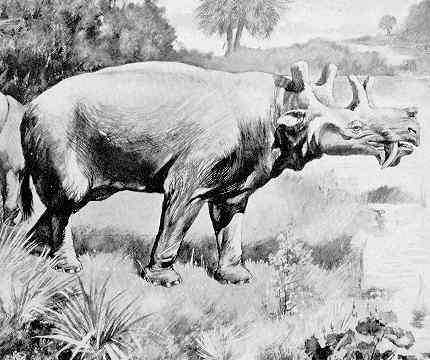| Palaeos: Cenozoic |  |
Eocene |
| PALEOGENE | Eocene |
| Page Back | Back: Paleocene | Back: Cretaceous | Up: Paleogene | Unit Home |
| Page Next | Next: Oligocene | Next: Neogene | Down: Ypresian | Time |
| Palaeos: Cenozoic |  |
Eocene |
| PALEOGENE | Eocene |
| Page Back | Back: Paleocene | Back: Cretaceous | Up: Paleogene | Unit Home |
| Page Next | Next: Oligocene | Next: Neogene | Down: Ypresian | Time |
|
Paleogene Paleocene Eocene Oligocene Neogene |

The rifting of the North Atlantic cut off North America from Europe, and South America lost links with Antarctica. India and Scotland were home to mountain-building episodes. The sea-level rose and seas invaded much of Africa, Australia, and Siberia.
Climates were generally warm or mild worldwide. Tropical palms flourished as far north as the London Basin. The unusual mixture of tropical and subtropical elements in the northern latitudes in the Eocene suggests that the mean annual temperature of these regions was not as high as in the present tropics, but that the flora was maintained by a greater rainfall than occurs in these northern latitudes today, with no pronounced seasonality in its distribution, and by the absence of winter frost.
Changes in vegetation during the Eocene epoch were limited chiefly to the migration of types of plants in response to climate changes.

The mammals continue to diversify, and the various archaic fauna flourished. Creodonts and amblypods (including the spectacular and ungainly Uintatheres of North America and Asia) continued to develop during the epoch
The Eocene saw the appearance of a number of direct evolutionary ancestors of modern animals.
The ancient hoofed condylarths gave way to more modern ungulates, and became extinct before the end of the epoch. The modern hoofed mammals - perissodactyls and artiodactyls - of Europe, Asia and North America, included proto- horses, tapirs, rhinoceroses, and camels, as well as extinct groups like the pig-like anthracotheres, horse-like chalicotheres, and rhinoceros-like Titanotheres. They were all small to begin with, about the size of a modern domestic cat, but some groups, especially the Titanotheres, quickly grew to huge size, before suddenly dying out in a mass-extinction of archaic forms at the end of the Eocene (it used to be believed that Titanotheres lived on to the Early Oligocene but modern dating shows this to be incorrect).
The rodents replaced the multituberculates in the small gnawing herbivore guild. Bats not unlike modern types appeared, evolving from primitive Insectivora. Primates including forest-dwelling ancestors of today's lemurs and tarsiers flourished in the trees.
The first aquatic mammals, whales and sea cows appeared in the oceans. The whales belonged to an extinct lineage called Archaeocetes, and quickly grew to huge size (Zeuglodon (more correctly Basilosaurus, a confusing name because this was a mammal not a reptile) attained 20 to 25 meters in length.
The Eocene saw the appearance of modern birds such as eagles, pelicans, quail, and vultures, as well as the great flightless Diatrymiformes, 2 meters or more in height, with a huge hooked beak that clearly indicated carnivorous habits. Such giant flightless birds, curiously reminiscent of their ancestors, the great theropod dinosaurs of the bygone Mesozoic, may have been able to develop because carnivorous mammals remained primitive and not very efficient.
Africa was separated by ocean on all sides, which allowed the development of a unique fauna in isolation from Europe, Asia and North America. There evolved not only the ancestors of elephants but also the hyrax, the monkey, and strange extinct forms such as the rhinoceros-like Embrithopods.
South America was another isolated island continent. It became home to a unique zoo of hoofed mammals, edentates, marsupials, and more giant flightless birds (Phorusrhacids).
Australia's fauna at this time is unknown, but would presumably consist of various indigenous marsupials, monotremes, crocodilians and lizards.
| Epoch | Sub-epoch | Standard Age (base) | European
Land Mammal Age (approximate correlation) |
North American
Land Mammal Age (approximate correlation) |
representative animal |
| Oligocene | Rupelian (33.9) | Orellan | |||
| Eocene
Epoch |
Late | Priabonian (37.2) | Seuvian | Late Chadronian
Early Chadronian |

Brontotherium |
| Headonian | |||||
| Middle | Bartonian (40.4) | Bartonian | Late Duchesnean
Early Duchesnean |
no image yet... | |
| Lutetian (48.6) | Lutetian | Late Uintan
Early Uintan |

Uintatherium |
||
| Late Bridgerian
Middle Bridgerian Early Bridgerian |
no image yet... | ||||
| Early | Ypresian (55.8) | Cuisian | no image yet... | ||
| Wasatachian | |||||
| Paleocene | Late | Thanetian (58.7) | Clarkforkian |
